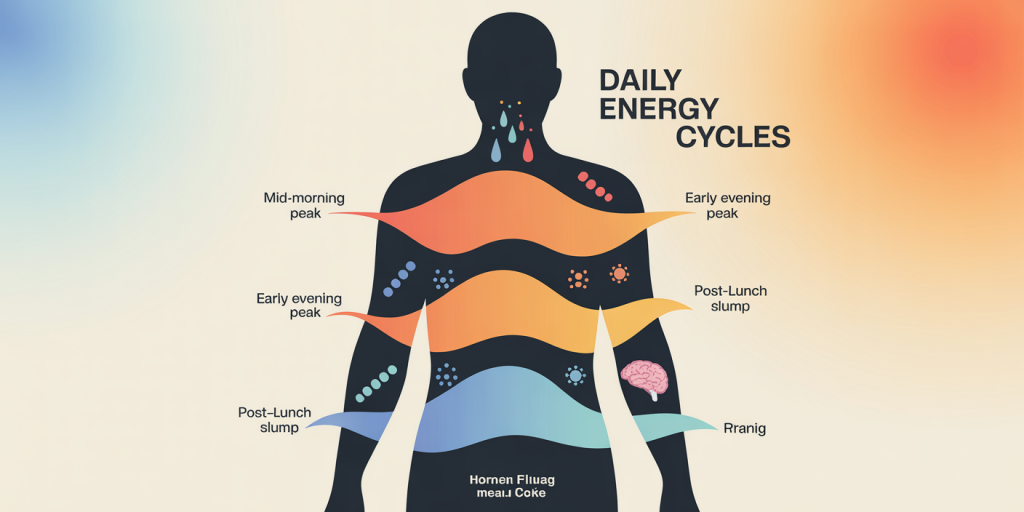The Psychology of Energy: Designing Your Day Around Peaks and Valleys
Understanding how energy fluctuates throughout the day is crucial for optimizing productivity, maintaining mental health, and enhancing overall well-being. Energy is not just physical; it encompasses emotional, cognitive, and psychological dimensions that influence how effectively we perform tasks, interact with others, and manage stress. By aligning daily schedules with natural energy patterns, individuals can work smarter, reduce burnout, and make better decisions.
Recent research underscores that most people experience cyclical patterns of high and low energy, often referred to as “peaks and valleys.” These fluctuations are influenced by circadian rhythms, lifestyle habits, and mental states. Recognizing these natural ebbs and flows allows for strategic planning of demanding and less-intensive activities accordingly.
The Science Behind Energy Cycles
Energy variations throughout the day are deeply tied to biological processes governed primarily by the circadian rhythm—a roughly 24-hour internal clock that regulates sleep-wake cycles, hormone release, and body temperature. This rhythm influences alertness and cognitive function. Studies show that cognitive performance peaks twice a day, typically mid-morning and early evening, with dips occurring post-lunch and late at night.

For instance, a classic research study conducted at Harvard University measured alertness and found a significant drop in performance after lunch, commonly known as the “afternoon slump.” This dip is a natural consequence of the body’s energy conservation strategy and hormonal fluctuations. Additionally, individual differences such as chronotypes (early birds vs. night owls) create variability in when peak energy occurs.
Beyond biology, psychological energy is impacted by motivational states, emotional well-being, and mental fatigue. Prolonged cognitive exertion without adequate breaks can deplete mental energy, reducing willpower and increasing errors. A study published in *Psychological Science* demonstrated that participants with intermittent breaks maintained higher levels of focus and experienced less decision fatigue.
Mapping Your Energy: Identifying Personal Peaks and Valleys
Understanding one’s own energy cycles is foundational for effective daily design. Many individuals fall into predictable patterns, but self-observation is key as external factors also play roles. A practical method is maintaining an “energy diary” for one to two weeks, recording subjective energy ratings every hour alongside the tasks being performed.
For example, Sarah, a marketing manager, discovered through her diary that her highest energy occurs from 9 AM to noon, while between 2 and 4 PM, she feels sluggish and less focused. With this insight, she adjusted her schedule to tackle key presentations and creative tasks during peak times and reserved routine email correspondence for her low-energy intervals.
To further quantify energy trends, wearable technology like Fitbit and Apple Watch can track heart rates, sleep patterns, and physical activity to provide personalized data on daily rhythms. Combining subjective notes with objective data leads to accurate identification of productive versus low-energy periods.

Practical Strategies for Designing Your Day
Once energy peaks and valleys are mapped, it becomes possible to tailor activities to maximize efficiency and well-being. High-concentration tasks such as problem-solving, brainstorming, or complex decision-making should be scheduled during peak energy times. Conversely, routine or mechanical tasks—answering emails, filing reports—are better suited for energy valleys.
Consider the case of David, a software developer who previously struggled with deadlines and exhaustion. After analyzing his energy pattern, he realized coding quality deteriorated after mid-afternoon. He shifted his coding sessions to morning hours and allocated post-lunch time for administrative work and short walks. As a result, David’s productivity increased by 30%, and burnout symptoms decreased significantly within months.
Integrating deliberate breaks is equally crucial to avoid mental depletion. Techniques like the Pomodoro Technique recommend working in focused intervals (e.g., 25 minutes) followed by short breaks, which help maintain sustained attention. Research shows that such cycles minimize cognitive fatigue and enhance motivation.
Furthermore, aligning physical needs with psychological energy supports overall balance. Adequate hydration, balanced nutrition, and exposure to natural light bolster alertness and mood. A study in the *Journal of Clinical Sleep Medicine* found that people who consumed nutrient-rich breakfasts reported sharper mental focus and steadier energy levels through the morning.
Comparative Analysis: Energy Management Approaches at Work
Many companies now acknowledge the necessity of designing work schedules around energy cycles. Comparing traditional fixed-hour models with flexible, energy-aligned models highlights benefits.
| Feature | Fixed-Hour Schedule | Energy-Aligned Flexible Schedule |
|---|---|---|
| Work Hours | 9 AM to 5 PM | Variable based on employee’s energy peak |
| Task Scheduling | Uniform task distribution | High-demand tasks during peak energy times |
| Break Structure | Standardized breaks (e.g., lunch) | Breaks aligned with individual energy dips |
| Productivity Impact | Moderate productivity fluctuations | Enhanced productivity and engagement |
| Employee Well-being | Higher burnout risk | Improved mental health and reduced fatigue |
For example, companies like Google and Atlassian allow employees to customize their work hours and focus on energy-based task planning. This flexibility has been linked to increased creativity and job satisfaction. In contrast, rigid schedules often fail to match employees’ natural energy rhythms, leading to decreased efficiency and increased absenteeism.

Psychological Energy and Decision-Making Quality
Decision-making quality directly correlates with available psychological energy. Known as decision fatigue, dwindling mental resources reduce the capacity to evaluate options critically. This phenomenon explains why many experience worse decisions as the day progresses or after multiple choices.
Barack Obama famously limited his daily clothing options to conserve decision-making energy for presidential matters. Similarly, studies involving surgeons indicate that operation outcomes worsen near the end of long shifts, underscoring the role of energy in high-stakes decisions.
To combat decision fatigue, important decisions should be scheduled during peak energy times, preferably in the morning. Automating or outsourcing routine choices, such as meal planning or attire, frees up cognitive resources. Additionally, regular breaks, healthy eating, and stress management enhance psychological energy reserves.
Future Perspectives: Integrating Technology and Personalized Energy Design
Advances in wearable technology, artificial intelligence, and big data analytics are set to revolutionize energy management. Personalized energy models combining biometric data, environmental factors, and psychological assessments will enable hyper-tailored daily schedules.
Imagine AI-powered personal assistants that not only track your energy cycles but proactively suggest task switching, break optimization, and even environmental adjustments like lighting or temperature modification based on your current energy state. Such systems could improve productivity by up to 25%, according to projections by Gartner Research.
Moreover, workplace designs will likely evolve to support dynamic energy management, incorporating flexible spaces, nap pods, and adjustable workstations. Companies might adopt “energy mapping” for teams, arranging collaboration and deep-focus periods around collective energy peaks to maximize output.
On a broader social level, education systems may integrate energy psychology principles, teaching students to self-regulate and optimize learning times according to personal rhythms. This shift could lead to enhanced cognitive development and reduced stress.
Harnessing the psychology of energy through strategic daily design offers a transformative approach to personal and professional life. By appreciating the biological and psychological underpinnings of energy cycles, individuals and organizations alike can unlock greater productivity, creativity, and well-being. As technology advances, precise, data-driven energy management will become an integral part of optimizing human performance in the years to come.
